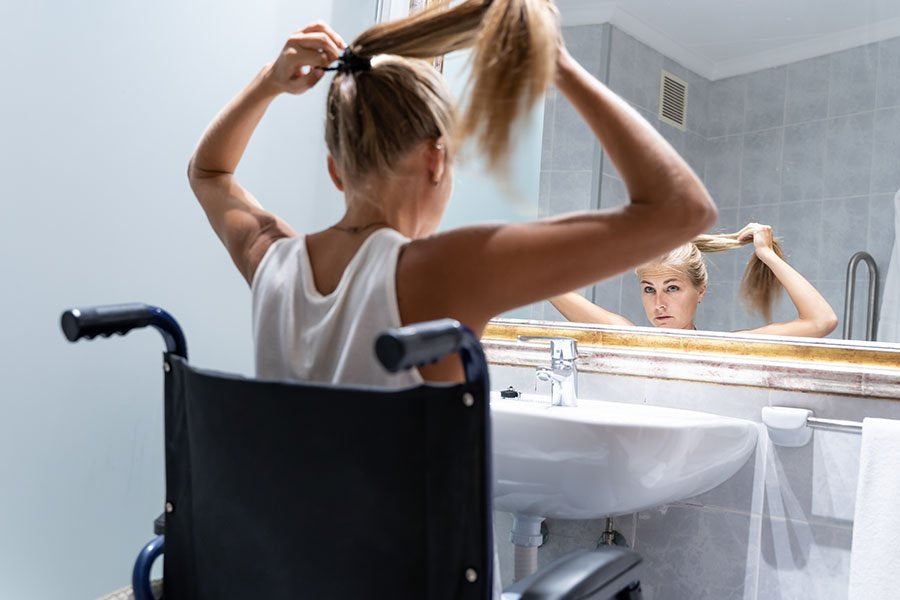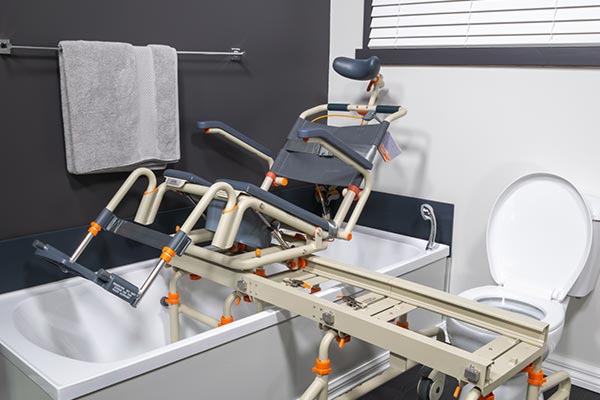-
Our bathroom routines are: highly personal
-
The bathroom routine is probably such second nature to most of us that we don’t give it a moment’s thought. Go in, do what you need to do and leave again. But these routines are built up over years of using the bathroom – what order we brush our teeth, do our hair, shave and even use the toilet. It might seem pretty minor but our bathroom routines are highly personal. It’s not until our bathroom use is interrupted from an injury or other mobility impairment that we truly appreciate what independence means to us.
-
Share the: support
-
Who will be involved in accessing the bathroom?
Deciding the people that will help you use the toilet and shower is an important step of this process. The OT may suggest engaging more than one person so the load is shared across multiple people – a parent, partner and a home carer.
Those involved need to be comfortable assisting you to get from anywhere in the home to the bathroom and preparing to use the toilet and shower without much trouble. It’s actually not always practical for a partner to take this role on, such as in circumstances where the partner is greatly outweighed by their mobility impaired loved one – for the safety of both parties a home carer may be a better decision.
-
![]()
Consider your: current routine
-
What order will you conduct bathroom activities?
Do you have a preference as to how you approach your morning and evening routines? What about during the day? It seems trivial until the process is underway and these minor details start to really matter.
Consider what your bathroom routine has been prior to the injury or impairment. What would make your life easier and more in line with your preferences? It’s important to let the OT know this information as they can to a large extent accommodate these requests, depending on the nature of the injury.
Some things that we know our Showerbuddy community of users think about during their bathroom planning:
- Do I use the toilet every morning before taking a shower?
- Can I still see myself in the mirror when seated?
- What hair products do I use each day?
- Can I apply my own deodorant or aftershave?
- How often do I shave?
- Do I brush my teeth before getting into the shower or after?
- What typical bathroom activities do I have during the day time (i.e. outside of the main morning and evening bathroom routines).
- Do I get undressed outside of the bathroom or enter the bathroom first and then get undressed for bathing?
This process of establishing the order of activities is all about surfacing what makes you the most comfortable.
Shower: Transfers
-
![]()
-
How will you get into and out of the shower unit?
Transferring into and out of the shower is one of the more difficult manual movements any of us make, unless we’re in a bathroom with an open plan ‘wet room’ style shower. For anyone with an injury they’re rehabilitating, the ‘transfer’ demands help through a combination of equipment and human support to execute safely.
The occupational therapist will do an assessment on your bathroom and shower against the status of your impairment to create a plan, but you may wish to contribute to this by thinking about your preferences here. At different stages of the physical rehab, you may be able to take on more of a role in the actual transfer, whether that’s mounting onto a transfer system, or moving a shower chair up to the shower for transfer.
Then consider what happens once bathing is over – do you dry yourself off in the shower before getting out? What help if any is required after this?
Don’t feel like you need answers to all these questions. An OT will ensure you have a safe bathing experience. But if you’ve got preferences with the transfer, it’s good to voice these.
-
Backup: plans
-
What are the back up plans in the event of a cleanup?
Accidents happen, more often than you might think. First, the speed at which one can get to the bathroom is not quick in most cases. And the actual process of getting over the toilet and completing the task doesn’t always happen with laser precision.
While this is certainly not a fun thing to cope with, your support plan should have this type of occurence planned out as much as anything else. Having your say around this scenario might feel awkward to talk about, but if everyone knows what to do in the situation well before it happens, there’s less stress when it does.
-
![]()
Assistive: equipment
-
What equipment will be available for both toilet and bath use?
Asking about the equipment options you have (as well as doing your own research) is a great way to get involved in your own rehabilitation and care plan.
As you might read in our other resources on this website, there’s a number of assistive technologies available to you – and in many cases more than one good option so personal preference does play a part in some cases.
Your OT may work with the physical therapist to choose equipment that supports the process of rehabilitation. Some equipment will also be able to be adjusted or even customised around different stages of mobility.
-
![]()
Assistive: equipment
-
What equipment will be available for both toilet and bath use?
Asking about the equipment options you have (as well as doing your own research) is a great way to get involved in your own rehabilitation and care plan.
As you might read in our other resources on this website, there’s a number of assistive technologies available to you – and in many cases more than one good option so personal preference does play a part in some cases.
Your OT may work with the physical therapist to choose equipment that supports the process of rehabilitation. Some equipment will also be able to be adjusted or even customised around different stages of mobility.
Rehabilitation: roadmap
-
![]()
What is the roadmap for rehabilitation and how does this affect the routine?
-
When dealing with an injury or impairment that has a long term outlook that’s positive, be it full recovery or a satisfactory regaining of mobility, it’s useful to understand what the key stages are in between today’s movement ability and that ideal future state.An occupational therapist will work with doctors and other health providers to build a clear understanding on the injury and the milestones that the individual is aiming to achieve and by when.
The bathroom activity can in many ways mirror these milestones by gradually introducing more personal input by the individual, such as bathing oneself with the removable shower head, or managing the toilet process solo. Setting goals is an important part of a physical therapy programme, and so too in bathroom usage.
Things may start out as ‘high touch’ in terms of the equipment and personal help to get through the bathroom routine, but at each milestone may drop off a particular aspect of support in order to empower the individual to do this themselves. It won’t be a sudden process whereby these tasks can’t be done and then can – like all motor skills and rehab exercises it’s a matter of practice and building up capability over a longer period. This obviously needs to be tempered with ensuring that bathing and using the toilet is still as pleasant an experience as possible.
-
Work with: an expert
-
Work with an occupational and/or physical therapist
The best source of information and planning is going to be with the OT and Home Care PT. They are able to apply their training and experience to understand your mobility levels at a given point in time, and put together a plan that offers you the best possible bathroom experience at the time.
They can engage with other support people like family or carers to help coordinate the help you may need. Beyond this, OTs and PTs are very well informed on the assistive technologies available and therefore can get demonstrations or arrange the ordering of this equipment for you.
If ever in doubt, your OT or PT are the best ones to talk to and get help to adjust the plan. That’s what they’re there for!
More information: about this topic
You can find useful information about this topic across the web via the following excellent online resources:
- Interventions to Reduce Risk for Patients with Toileting Needs – University of Nebraska Medical Centre
- How can physical therapy help? – MedicalNewsToday.com






